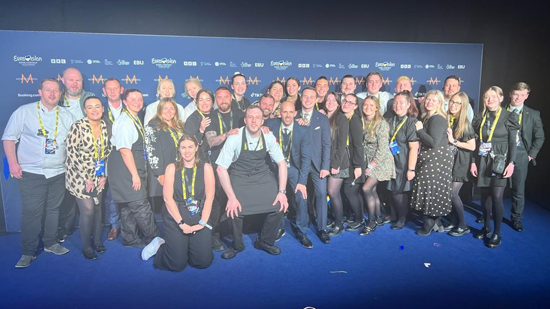Food and drink to make a song and dance about
On Saturday 13th May, the eyes of Europe were firmly fixed on Merseyside as the Eurovision Song Contest Grand Final unfolded at the M&S Bank Arena Liverpool. As catering partner of The ACC Liverpool Group, the Sodexo Live! team was on hand throughout the entire contest, ensuring the smooth running of the event and the hospitality for thousands of guests throughout the week.
During the week our 700 staff clocked up some impressive stats, while ensuring guests, press and other stakeholders were well looked after:
- Throughout the week the venue had more than 60,000 attendees watch nine live shows
- As media interest was so huge in Eurovision, Sodexo Live! fed and watered up to 1,200 members of the press per day
- 19 adrenalin-packed hospitality boxes were looked after across the nine shows
- We had a dedicated team of five looking after the green room for each act during the shows and for the commentators
- 36,000 bowl food items were served in addition to 19,000 desserts
- Some of the most popular food items included Ukrainian loaded fries, churros, and Greek gyros. Plus 1,000 Eurovision branded macarons were made by our chefs
- Our Sodexo Live! staff worked 2,300 shifts and racked up more than 16 million combined steps
- As health and safety is our number one priority the team conducted six safety walks throughout the week
- Food waste is also incredibly important to Sodexo Live!, so following the final, working with the Liverpool Zero Waste Community, three pallets of surplus food was delivered free to families, schools, children’s groups and care homes across Liverpool and the Wirral
The event, which was being hosted on behalf of last year’s winners, the Ukraine, hadn’t been on British soil since 1998. Feedback from the venue, our staff, delegates, and guests following the event has been incredibly positive.
Ben Williams, commercial director of The ACC Liverpool Group, operator of the M&S Bank Arena, together with adjoining ACC Liverpool and Exhibition Centre Liverpool, said:
“Sodexo Live! shares our passion for hosting memorable experiences and Eurovision presented an opportunity like no other to showcase this.
“Central to any live event experience is top class service and fantastic hospitality and Sodexo Live! absolutely delivered on this throughout the week of Eurovision shows, catering for thousands of visitors from around the world.
“The team is an extension of our own staff and it’s this partnership and teamwork that ensures a successful, seamless event experience for all our customers.”
Sodexo Live! and the wider Sodexo Group is based on strong values, which are similar to those of Eurovision. Sean Haley, CEO Sodexo UK and Ireland, shares his thoughts:
“At Sodexo our local teams serve thousands of consumers every day, operating in incredibly multi-national and diverse workforces. Last year, the Eurovision Song Contest reached more than 161 million people across its three live shows, in turn creating a sense of belonging for these fans and the chance to celebrate with likeminded others. This sense of belonging is so powerful, and we continue to strive to further create this in our teams, so they feel they can belong, act and thrive. Eurovision is famous for its diversity and celebration of culture. At Sodexo, we recognise that we are all the stronger because of the differences every person brings to work on a daily basis, and many of these colleagues worked at the contest. Here in the UK&I we have 83 Ukrainian employees across the business, and the colleagues working at the contest did an excellent job helping to deliver Eurovision on their behalf, given Ukraine couldn’t host this year’s event.”
As a huge fan and passionate advocate of the live entertainment industry, Rebecca Kane Burton, CEO Sodexo Live! UK and Ireland, explains what it means to her and Sodexo Live!:
“Sodexo Live! works tirelessly to create memorable experiences, and major events like Eurovision are definitely a career-high for our teams, and an event our guests will talk about for years to come.
“Helping our venue partners thrive is what makes Sodexo Live! tick, while at the same time benefiting the communities we serve. I don’t think there can be any stronger example of this in practice than Eurovision. Hosting the event has firmly put The ACC Liverpool Group on the map, with the world’s eyes and media following the contest. The impact and legacy of this event will be massive for Liverpool. This is why I love the live industry. It is the life blood for towns and cities across the country. A strong events and entertainment offering opens up so many economic opportunities, and helping to deliver Eurovision is fundamental to our work with the team at The ACC Liverpool Group. I thank them for their ongoing support and partnership.
“I am also incredibly proud of what our teams have delivered for the contest – the numbers and stats speak for themselves. I am so thankful to our team, who showcased our innovative offer to thousands of excited fans, press and guests.
“Sadly, the UK entry did not win, so we won’t be hosting the event at one of our venues next year, but here’s hoping we don’t have to wait another 25 years for it to come back to home soil.”
What delegates and guests said…
"The food was really delicious, and your team presented it all beautifully. They couldn’t have done more for our guests"
"Allergy catering in the hospitality area was super. Each area had an allergy champion in a green apron, and they found me loads of yummy GF food"
"We had hospitality tickets and it was amazing! Barely any queue, lovely lounge with free UKraine fusion inspired food, bar, and music to get in the party mood"
What our staff said
"This has been the best week I have ever worked"
"It's been amazing"
"Loved it!"
"Please can I work tonight?”
